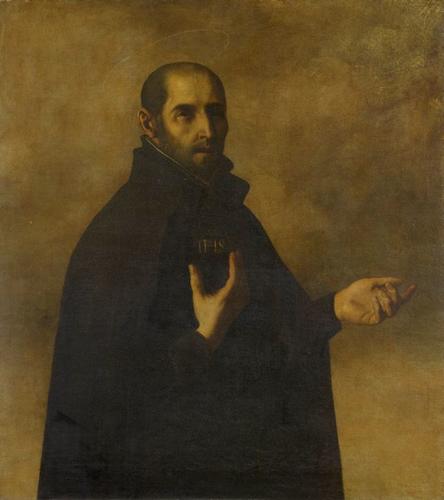St Ignatius Loyola c.1634-50
Oil on canvas | 100.9 x 89.4 cm (support, canvas/panel/stretcher external) | RCIN 402879
-
Francisco de Zurbarán was one of the great masters of the school of Seville, renowned for his powerful and realistic interpretation of monastic life in 17th-century Spain. Zurbarán’s paintings of single saints can be seen as a continuation of those that were painted in Seville in early seventeenth century, beginning with those of Francisco Pacheco (1564-1644) and continuing with the work of Francisco Varela (c.1580-1645) and Juan del Castillo (1590-1640). The majority of Zurbarán’s paintings of saints were commissioned as series and executed largely by assistants; however, this painting is not part of any known series. Additionally, the painting was not widely copied, suggesting it may have been a one-off commission.
Ignatius of Loyola (1491-1556) was the founder and first General of the Society of Jesus, better known as the Jesuits. He was beatified by Pope Paul V on 27 July 1609, and canonised by Pope Gregory XV on 12 March 1622. At the time of Loyola's death in 1556, several were made in plaster and wax, an example of which survives in Rome. A written description by contemporary Jesuit biographer Pedro de Ribadeneyra was also in circulation shortly after Loyola's death and described his appearance in detail:
His face was distinguished, the forhead broad and unwrinkled, the eyes deep set, the lids contracted and scored with the tears he continually shed, the ears of average size, the nose prominent and aquiline, the fair complexion florid. What with his baldness, his appearance was very venerable. The expression of his face was gladly grave and gravely glad, so that by his serenity he cheered those who looked at him and by his seriousness he calmed them.
It was from this description and on the instruction of Ribadeneyra that in1585 Alonso Sanchez Coello (1532-1588) painted a portrait of Loyola for the Casa Professa de los Jesuitas in Madrid. Considered the most successful likeness to date, Coello's portrait became the official image of Loyola and template for numerous future representations. At least on copy of the death mask was known to be in Seville in the early 17th century. In 1610 a festival was held in the city to celebrate the beatification of St Ignatius, at which time a number of portraits were made, including the polychrome statue by Juan Martinez Montanes (1568-1649) in the Church of the Annunciation, Seville University. An engraved portrait of Loyola appeared as the frontispiece to Francisco de Luque Fajardo's Account of the Festival in Seville on the occasion of the Beatification of the Glorious St Ignatius, founder of the Company of Jesus (Seville, 1610). Both portraits follow Coello's model, but it is thought that the artists also had access to a plaster copy of the death mask then in the collection of Sevillian artist Francisco Pacheco.
Zurbaran's painting, which follows this pattern, may possibly have been painted in the years following the artist's return to Seville in 1634. During this period, Zurbaran began to introduce fine open-air effects to his canvases, while the figures and their heavy monastic clothing retained the static density and fullness of previous years. This painting has almost certainly been cut down from a full-length composition. St Ignatius Loyola is shown in the robes of the Superior General of the Society of Jesus, gesturing to the IHS symbol adopted by the order.
Provenance
Purchased by Gruner of behalf of Queen Victoria for £40.10.0 on the 30 May 1853, from the sale of pictures belonging to King Louis Philippe, formerly in the collection of Frank Hall Standish, by whom bequeathed to King Louis Philippe in 1840; recorded in the State Visitors' Dressing Room no 238 at Buckingham Palace in 1876
-
Creator(s)
Acquirer(s)
-
Medium and techniques
Oil on canvas
Measurements
100.9 x 89.4 cm (support, canvas/panel/stretcher external)
125.4 x 115.2 x 10.0 cm (frame, external)








